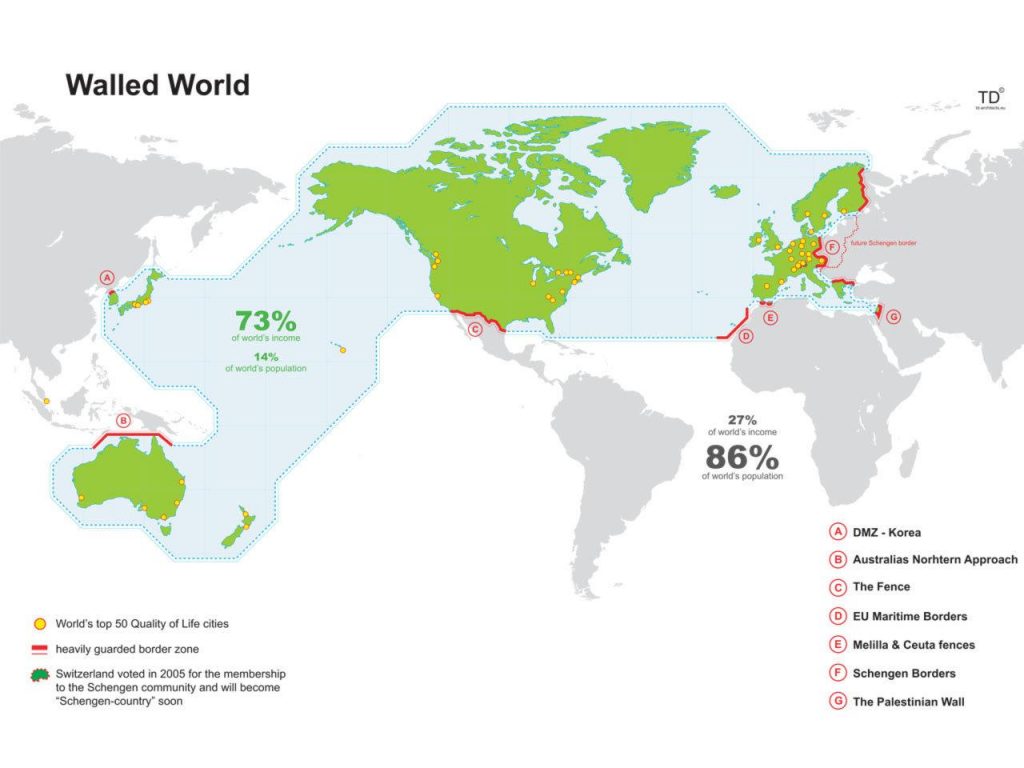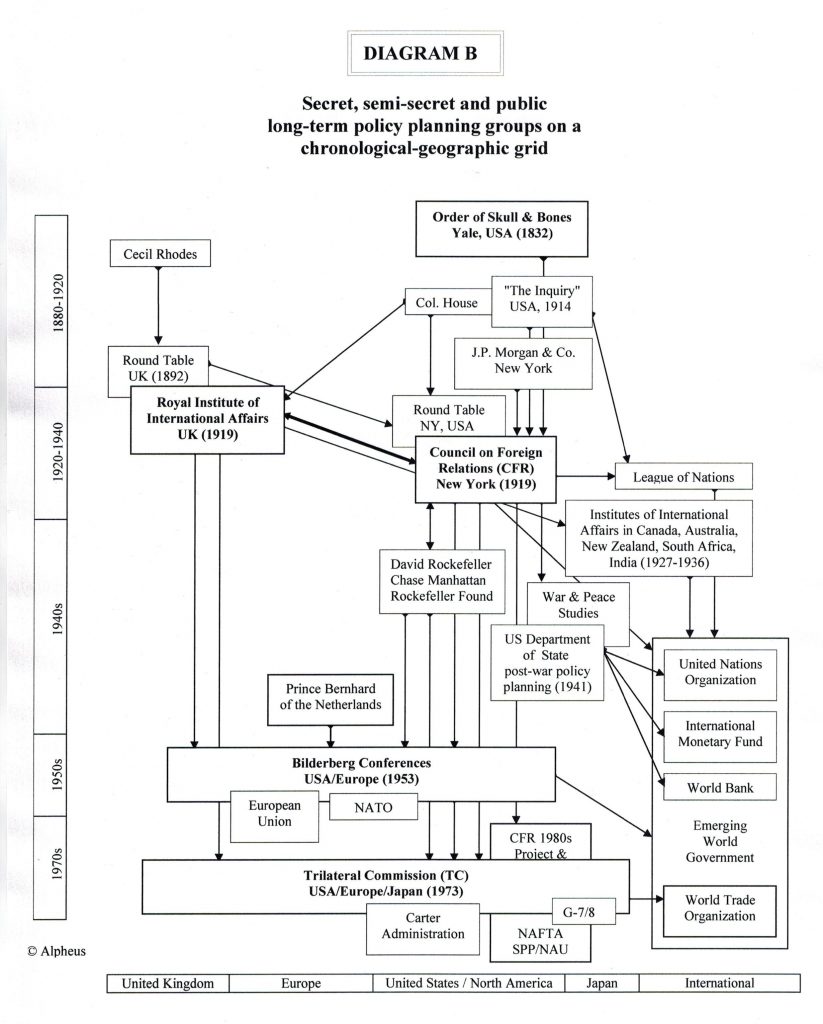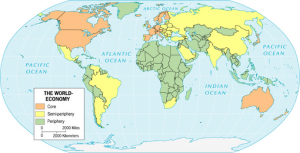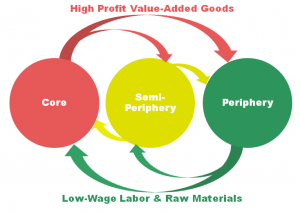Often maps can convey ideas better than words. One example is this terrific map I recently found illustrating the geographical dimension of the ‘Trilateral West’ or ‘North-Western Triad’, which is composed of the three economic power houses, Japan, the US and the EU, including some of its loyal satellites like South Korea, Australia, New Zealand, Canada, Switzerland and Israel (Deutinger, 2009). It clearly indicates the porous maritime and hard continental borders keeping this walled world from getting inundated by political and economic refugees. In this article I will address three discernible planning phases since the start of WW II by which this walled arrangement came into being.
Fig 1. The Walled World (Deutinger, 2009)
Phase I: The War and Peace Studies Project
Historically speaking the foundation for this arrangement was the post-WW II Breton Woods system, which international order was devised by the power elites of the US and Europe in their elite, long-term policy planning think tanks, the New York based Council on Foreign Relations (CFR) and the London based Royal Institute for International Affairs (RIIA). Already in 1939 the CFR saw the need for a revamped international system and started even before the US was involved in the war with an organized study effort named ‘The War and Peace Studies Project’. This project was initiated in order to devise a best possible international order for its corporate members, predominantly Wall Street banks and international conglomerates (Shoup & Minter, 1977; Wala, 1994).
Starting in 1941 the study groups in the CFR were intimately cooperating with the US State Department’s own research groups, which incorporated many of the CFR’s ideas and personnel. The main institutional framework proposed by the State Department was the United Nations (UN), the International Monetary Fund (IMF) and the International Bank for Reconstruction and Development (the ‘World Bank’). At a series of conferences by the allies–Breton Woods being the most important one–the proposals were adopted and these institutions then all played important roles in the transition from a formal colonialist-imperialist international order to an informal imperialist order of nominally independent countries. The dollar, pegged to gold at $35 per ounce, became the basic currency for international trade. Only much later the originally planned World Trade Organization (WTO) was founded.
Within this international political-economic legal framework the important trans-national agents of influence were American and European big investment houses, trans-national corporations (TNCs), intelligence agencies and military alliances, with NATO being the most important one integrating the US and Europe.
Initially the US was the hegemon, but when Europe got back on its feet with the help of the Marshall Plan in the early 1950s and frictions developed between them, the very elite yearly Bilderberg conferences were started in 1953 to informally address US-European strategic differences and come to more coordinated policies. Many if not most of the US attendees who show up regularly are members of the CFR. And behind both there was the continual presence of David Rockefeller. These costly, high-security conferences are still held on a yearly basis, the last one in 2019 in Montreux, Switzerland (Thompson 1980, van der Pijl 1984, Richardson 2011, 2012, Schuller 2014).
Phase II: The 1980s Project
In the early 1970s, with the stellar rise of Japan and some serious problems in the international system like the oil crisis, the looming US defeat in Vietnam, Third World revolutions and the decoupling of the dollar from gold, it was time for the CFR, under the chairmanship of David Rockefeller, to re-address the whole international set-up with another multi-year round of studies and consultations now named ‘The 1980s Project’. Out of this came the further integration of Japan into the system by giving its corporate elite a big seat at the 1973 founded Trilateral Commission (TC) with Japan, the US and Europe each given a third of member- and leadership positions; the institution of international summits like the G-7 and G-20; and the start of neoliberalism initially implemented by the TC dominated Carter administration lead by TC founding member Jimmy Carter and TC main architect and executive director Zbigniew Brzezinski. This can be conceptualized as corporate democrats taking over the Democratic Party from the New Deal / Great Society social democrats. The establishment of the WTO and NAFTA can also be credited on its account (Shoup & Minter 1977; Shoup, 1980; Domhoff 1982; Sklar, 1980; Gill 1991, Domhoff 2013; Shoup 2015).
Because this system of ‘world management’ is composed of these three major and coordinating imperialist centers, it can be named the trilateral system, or the ‘North-Western Triad’, or as I do, the ‘Trilateral West’ with Japan seen as being in the ‘far west’ of the system as ‘The Walled World’ map is geo-spatially organized, and not as usual in the ‘far east’.
Phase III: Renewing America Initiative
A third round of in-depth CFR studies were commenced in 2011 under the leadership of CFR president Richard Haass. It was named the ‘Renewing America Initiative’, because the problems the US was increasingly facing were now domestic in nature: a crumbling infrastructure; a failing educational system; and loss of manufacturing jobs, and thereby a diminished power base to project influence internationally. The CFR also admitted, through Haass, that the US had gone from sole super power status as the indispensable, benign hegemon after the end of the Cold War to being a ‘first among equals’. To address the problems at the domestic front pensions, health care and other entitlements had to be cut; unions had to be curbed; congressional gridlock had to be broken (by a coalition of conservative democrats, moderate republicans and independents); and in foreign policy there would have to be an economic and military ‘pivot’ to Pacific Asia away from the Middle East. Major geo-economic initiatives were the Trans Pacific Partnership (TTP) and the Transatlantic Trade and Investment Partnership (TTIP). With the current Trump administration this agenda is in jeopardy, mainly because the moderate, status quo, internationalist, corporate Republicans started to lose power to emerging radical, nationalist, authoritarian Republicans. It is possible that, because of a back-lash against the semi-fascist and corrupt Trump administration, the corporate democrats and republicans will get the upper hand again and can revive their internationalist agenda after 2020 (Shoup, 2015).
The Deep History
The deep history of America’s premier foreign policy think tank, the CFR, is a story quite by itself. It was founded together with its UK sister organization, the RIIA, during the aftermath of the first world war when internationalist-oriented parties in the US became concerned about the US not joining the League of Nations (Quigley, 1966,1981). Feeding ideas and personnel into the CFR were some intriguing groups and individual movers and shakers. First of all, with the CFR as its extension, there was an informal study group concerned about post-WW I economic and political issues. This group had the name ‘The Inquiry’ with presidential advisor Col. House as its main force. House was also involved in the American branch of the semi-secret organization the ‘Round Table’, which was the US satellite of its UK mother lodge started by Cecil Rhodes, the premier UK imperialist planner. The British organization had many informal names besides its official one of ‘Round Table’, like ‘Milner’s Kindergarten’ and the ‘Cliveden Set’. The CFR can be conceptualized as the US Round Table front organization. Also representatives of J.P. Morgan & Co. and patriarchs of the Yale based fraternity Skull & Bones were at the founding table of the CFR (Sutton, 1986).
Many years ago I created a geographical-chronological grid of the main semi-secret groups, think tanks, international organizations and some individuals involved in this narrative of globalization. I cut it down to the essentials and the grid admittedly lacks a twenty-first century update.
Fig. 2. Chronological-geographic Grid
World System Analysis
There are different ways to conceptualize these international dynamics. In the framework of sociologist Wallerstein’s ‘world system analysis’ the Trilateral West is the ‘core’ of the world system imposing its political and economic will on the rest of the world, which is divided in a sphere of semi-peripheral countries, which have some development, and peripheral countries, which are under-developed (though there is a debate on what actually ‘development’ means)(Wallerstein, 2004).
Fig. 3. The World-Economy (Elwell, 2013)
In the above map the geographically integrated nature of the Trilateral West with its maritime and hard borders is somewhat lost. The Deutinger map has North America in the middle instead of Europe, which also reflects its importance . . . for now (a third map with China in the middle might become the more explanatory map in the coming decades).
Fig 4. Flow of Goods, Resources and Labor
Which brings me to the dynamic aspect of this international structure. Basically the core produces high-tech, high-profit goods for its domestic and foreign markets while taking in low-price raw materials and low wage workers. The periphery is in the unenviable position where it generates hardly any high-tech, high-profit goods and has to give up its resources and labor for a pittance. In between are the somewhat developed, semi-periphery countries with an intermediary, buffering role between the core and the periphery being both exploiter and exploitee. Countries in the core will try to stay in that position while the others will try to go at least one status up.
The core mostly has a hegemon, usually the country with the largest navy, merchant fleet, manufacturing base and financial institutions. In Wallerstein’s chronology the Dutch in the 17th century came first, and in the 18th and 19th century it was the UK. Then after a period of transition between 1914 and 1945, which knocked out Germany as a candidate, the USA became the hegemon. Anno 2020 the power and status of the USA is diminishing year by year, not the least because of the scandalous incompetence of the Trump administration, and that of China is rising. With China joining the WTO, G-20, the informal Davos, and the adoption of the adapted Trans-Pacific Partnership (TPP), China will become increasingly incorporated into the core of the globalized system from which position it is already reforming and protecting it, and will probably take over the role of hegemon in a few decades.
This transformation of a major Communist power from antagonist, to resister, to participant, to reformer, to protector and finally to leader of the international capitalist system is quite extraordinary (Zhihai, 2011). Some would see this as a diabolical and long established plot between Wall Street and Communists, while others would see this as the logical outcome once China went from failing Communism to authoritarian state capitalism–being communist only in name–and thereby going back to its traditional position of dominance in the world economy which it had lost to the west for about four centuries (Frank, 1998; Arrighi 2007).
It is also possible that this process will be halted by a cold or hot face-off between China and Russia on one hand (they have been long-time strategic allies) and the Trilateral West on the other. And the factors leading into this already smoldering conflict are legion. Botched intelligence operations, electoral interference, sanctions, tariffs, counter-tariffs, right-wing anti-globalization populism, the correlated rise of nationalism–and all of this now aggravated by the pandemic and global recession pushing countries into increased self-sufficiency–can result in the de-coupling of the two main spheres of geopolitical power and put them at severe loggerheads. Cooler and more competent heads are necessary to navigate the tectonic economic and political shifts caused by China’s rise.
At the same time alternatives have to be developed to deconstruct the juggernaut of imperialistic globalization. Most importantly the hidden engine of the globalization process, the current monetary system, will have to be reformed. Humongous streams of capital can be re-directed, even created, to help a controlled process of de-globalization take place focused on a social-economic development of the periphery and semi-periphery, which is non-exploitative and ecologically sustainable, while the Trilateral West itself will have to tackle its own inequalities through raising taxes on corporations and the rich, and nationalize their currencies to redirect capital from financial speculation to investments in infrastructure, either physical, health or educational in the context of a Green New Deal. Sounds big, but the research underpinning such radical reforms is now quite large and monetary reform proposals are already on the shelf and could be activated in a matter of weeks.*
Originally, in an on-line presentation, the above narrative was embedded in an even larger one, i.e. of the dynamics of civilizations since the dawn of history till the relative dominance of the West. This will have to wait for another article. For now, I hope to have sketched a historical, institutional and geographical framework wide enough to get some grip on international developments.
* For more on monetary theory and reform see: Zarlenga 2002, 2009; Kumhof & Benes 2012; Ingham 2004; Werner 2012, 2014; Egnatz 2015; Huber 2017; Di Muzio & Robbins 2016, 2017, 2020; and Hammon & Pash 2019. Browse also this small bibliography with introductory items for initial orientation and this weighted list of of best studies based on the opinion of a group of experts.
Sources
Arrighi, Giovanni. 2007. Adam Smith in Beijing: Lineages of the Twenty-first Century. London & New York: Verso.
Aubourg, Valerie. 2003. “Organizing Atlanticism: The Bilderberg Group and the Atlantic Institute, 1952–1963”. Intelligence and National Security, 18/2 (2003): 92-105. Comparing two private, transatlantic organizations which started in the 1950s and flourished in the 1960s.
Deutinger, Theo. 2009. “Walled World“. Amsterdam & Salzburg: TD Architects. Retrieved 17 May 2020.
Di Muzio, Tim & Robbins, Richard. 2016. Debt as Power: Theory for a Global Age. Manchester, UK: Manchester U.P.
Di Muzio, Tim & Robbins, Richard. 2017. An Anthropology of Money: A Critical Introduction. London: Routledge.
Di Muzio, Tim & Robbins, Richard. 2020. “Capitalized Money, Austerity and the Math of Capitalism“. Current Sociology, 68/2: 149–168.
Domhoff, G. William.1969. The Higher Circles: The Governing Class in America: An Investigation of the Men and Women who govern our Country. New York: Vintage Books. Penetrating sociological study of the power elite. Special chapter on the CFR and one on conspiricist views of the upper-class.
Domhoff, G. William. 1978. The Powers That Be: Processes of Ruling Class Domination In America. New York: Vintage Books. Study of the ways and means of power-elite hegemony. Most revealing chapter on the role of the CFR in creating the UN, IMF and World-bank.
Domhoff, G. William. 2013. The Myth of Liberal Ascendancy: Corporate Dominance from the Great Depression to the Great Recession. Boulder & London: Paradigm Publishers.
Egnatz, Nick. 2014. “Linking Social Justice to Monetary Reform”. Alpheus. 25 Dec 2014.
Elwell, Frank W. 2013. “Wallerstein’s World-Systems Theory“. Retrieved May 17, 2020.
Eringer, Robert. 1980. The Global Manipulators: The Bilderberg Group… the Trilateral Commission… covert power groups of the West. Bristol, UK: Pentacle Books. An early journalistic foray into Bilderberg-land and how the media failed the public. First chapter here.
Estulin, Daniel. 2007. The True Story of the Bilderberg Group. Walterville, OR: TrineDay
“For some 15 years, Estulin has been a thorn in the sides of the Bilderbergers, relentlessly hunting down their secret meeting places, gaining inside sources who divulge what goes on behind closed doors, even photographing attendees and publicly disclosing it all.”
Frank, Andre Gunder. 1998. ReOrient: Global Economy in the Asian Age. Berkeley: University of California Press.
Gill, Stephen. 1991. American Hegemony and the Trilateral Commission. Cambridge, UK & New York: Cambridge UP.
Hammon, Virginia & Pash, Mark. 2019. How We Pay for a Better World. Portland: Great Democracy Media.
Huber, Joseph. 2017. Sovereign Money. Beyond Reserve Banking. London: Palgrave Macmillan.
Ingham, Geoffrey. 2004. “The Emergence of Capitalist Credit Money.” In: L. Randall Wray (Ed.), Credit and State Theories of Money: The Contributions of A. Mitchell Innes. Edward Elgar. 173-223.
Kumhof, Michael & Benes, Jaromir. 2012. “The Chicago Plan Revisited“. IMF Working Papers 12/202. Washington: International Monetary Fund.
Miller. Todd. 2019. “Israel’s Occupation Inspired the Brutal Security Regime at the US-Mexico Border“. Truthout, 17 Oct 2019. Excerpt from Empire of Borders: The Expansion of the U.S. Border Around the World. London: Verso Books.
Quigley, Carroll. 1966. Tragedy and Hope: A History of the World in our Time. New York: Macmillan. Tucked away in a vast narrative of 1870-1945 world history, eminent historian reveals evidence of the existence of a secret cabal within the Anglo-American establishment and its impact on history.
Quigley, Carroll. 1981. The Anglo-American Establishment: From Rhodes to Cliveden. New York: Books in Focus. Eminent historian reveals historical roots of a secret cabal within the Anglo-American establishment. Study written in 1946 and finally published posthumously in 1981.
Richardson, Ian. “Bilderberg, Elite Consensus and the Media“. The Huffington Post, UK Edition. July 13, 2011. Web.
Richardson, Ian; Andrew Kakabadse; Nada Kakabadse. 2012. “Shaping Global Political Realities: The Workings of Transnational Elite Networks“. World Financial Review, March-April 2012.
Ronson, Jon. 2002. Them: Adventures with Extremists. New York: Simon & Schuster. Two chapters dedicated to his adventures to find out more about Bilderberg.
Ross Sr., Robert Gaylon. 1995. Who’s Who of the Elite: Members of the Bilderbergs, Council on Foreign Relations, Trilateral Commission, and Skull & Bones Society. N.p.; RIE.
“The book is an excellent “reference” as to specifically who is affiliated with each specific elite organization, as well as cross-referencing what branch of government, industry, etc. their “day-job” corresponds with”. Different editions available.
Schuller, Govert. 2014. “Bilderberg 2014: A Secretive Elite Wonders if Privacy Exists“. Alpheus, October 2014.
Scott, Peter Dale. 1993. Deep Politics and the Death of JFK. Berkeley and Los Angeles: University of California Press,.
Shoup, Laurence H. and Minter, William. 1977. Imperial Brain Trust: The Council on Foreign Relations and United States Foreign Policy. New York: Monthly Review Press. Academic study of the history, network and influence of the CFR, especially its architecture of the post-WW II order with institutes like the UN, IMF and World Bank, and later its 1980s Project laying the groundwork for trilateralism, the G-7 Summits and the Trilateral Commission.
Shoup, Laurence H. 1980. The Carter Presidency and Beyond: Power and Politics in the 1980’s. Palo Alto, CA: Ramparts Press.
Shoup, Laurence H. 2015. Wall Street’s Think Tank: The Council on Foreign Relations and the Empire of Neoliberal Geopolitics, 1976-2014. New York: Monthly Review Press. Continuation of Imperial Brain Trust.
Sklar, Holly (Editor). 1980. Trilateralism: The Trilateral Commission and Elite Planning for World Management. Boston: South End Press. Collection of case studies of the imperialist power of the TC. Includes an annotated TC membership list.
Sutton, Antony and Patrick Wood. 1978, 1981. Trilaterals Over Washington. 2 vols. Scottsdale, Arizona: August Corp. Groundbreaking study on the Trilateral Commission by academic investigators.
Sutton, Antony. 1986. America’s Secret Establishment: An Introduction to the Order of Skull & Bones. Billings, Montana: Liberty House. After obtaining the membership list of this Yale senior semi-secret society, Sutton could connect the dots from his Wall Street trilogy and lay out the central role S&B played in fomenting wars and revolutions and controlling education.
Thompson, Peter. 1980. “Bilderberg and the West”. In: Trilateralism, Holly Sklar (Editor).
van der Pijl, Kees. 1984. The Making of an Atlantic Ruling Class. London: Verso. Study of the development and integration of the American and West European post-WWII corporate elite.
Wala, Michael. 1994. The Council on Foreign Relations and American Foreign Policy in the Early Cold War. Oxford & New York: Berghahn Books. “Based on extensive analysis of primary sources, this book clearly delineates the Councils activities- its study and discussion groups and its publications – and the developing international political, military, and economic situations.”
Wallerstein, Immanuel. 1974-1989. The Modern World-System. 3 volumes. New York & San Diego & London: Academic Press.
Wallerstein, Immanuel. 2000. The Essential Wallerstein. New York: The New Press.
Wallerstein, Immanuel. 2004. World-Systems Analysis: An Introduction. Durham, NC: Duke University Press. Short overview and introduction to his comprehensive approach to world history.
Werner, Richard A. 2012. “How to Turn Banks into Financial Intermediaries and Restore Money Creation and Allocation Powers to the State”. University of Southampton, Center for Banking, Finance and Sustainable Development, Policy Discussion Paper, No. 3-12 (8 Nov 2012): 2-9.
Werner, Richard A. 2016. “A lost century in economics: Three theories of banking and the conclusive evidence”. International Review of Financial Analysis, 46 (July 2016): 361-379.
Zarlenga, Stephen. 2009 (2006). “Presenting the American Monetary Act”. Valatie, NY: American Monetary Institute.
Zarlenga, Stephen. 2002. The Lost Science of Money: The Mythology of Money – the Story of Power. Valatie, NY: American Monetary Institute.
Zhihai, X. I. E. 2011. “The Rise of China and its Growing Role in International Organizations“. Journal of Modern Chinese Studies, 4/1: 85-96.




